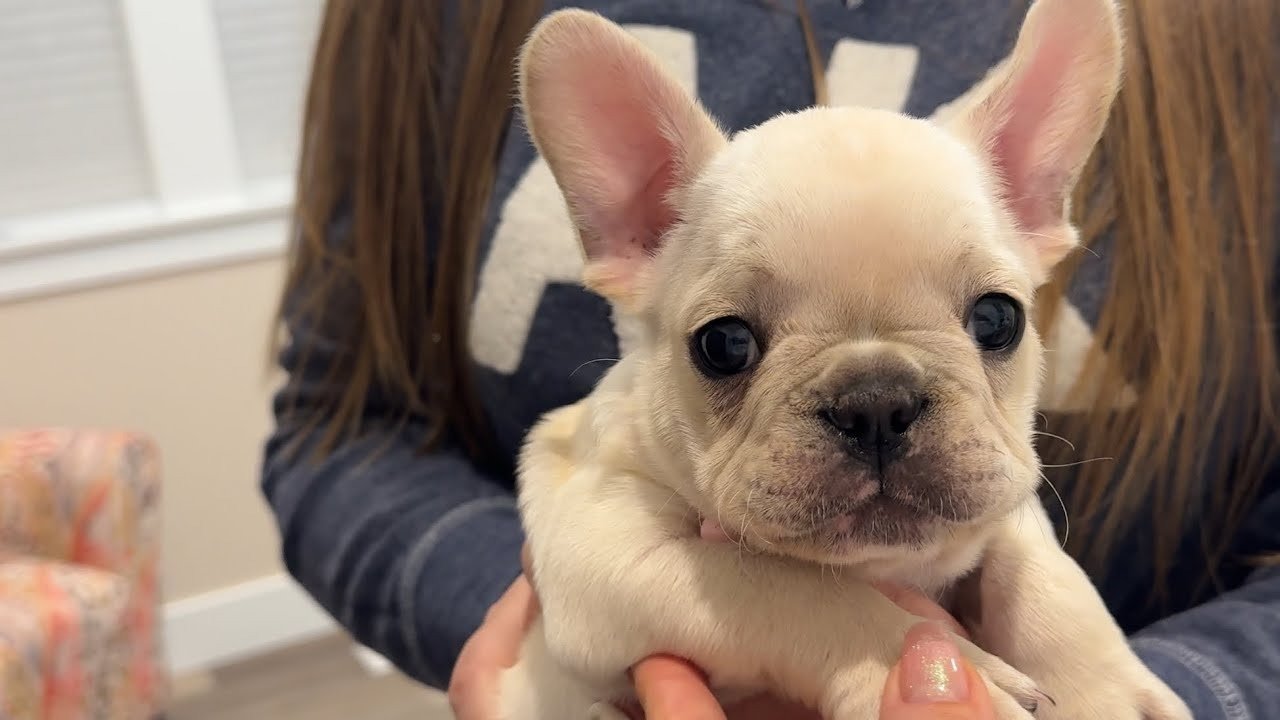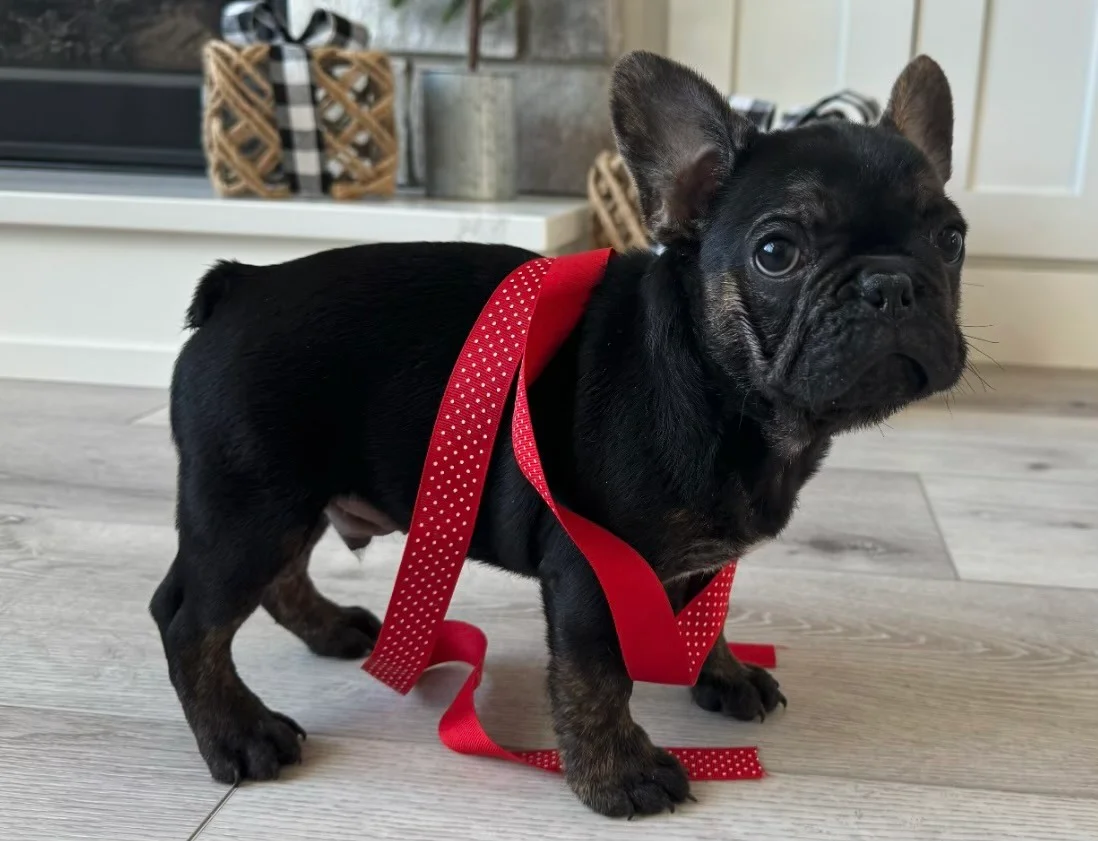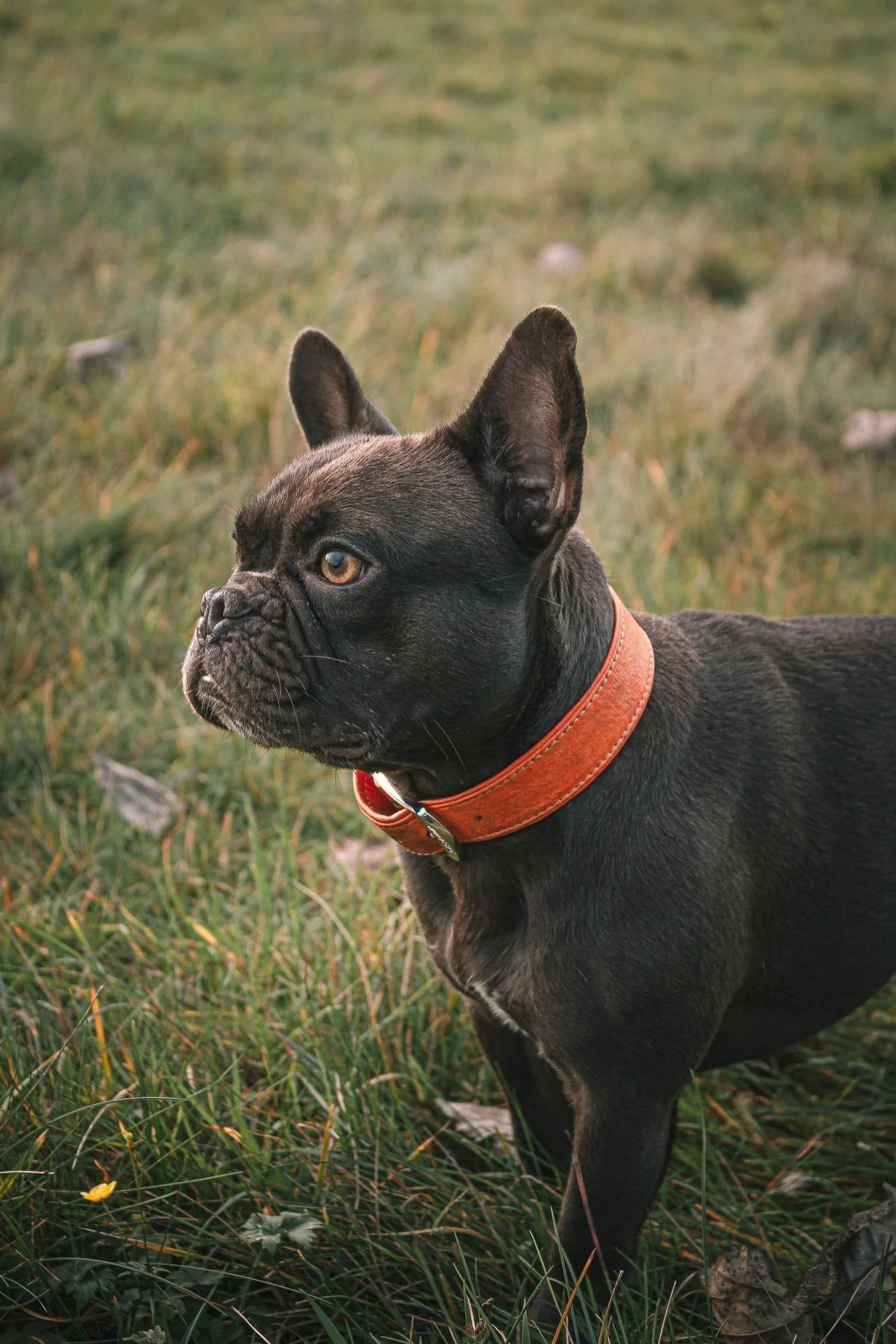Prospective Owner FAQs
Prospective Owner FAQs
›
Is the French Bulldog recognized by the AKC and is there a breed standard?
Is the French Bulldog recognized by the AKC and is there a breed standard?
 You bet – in fact, the AKC recognized the French Bulldog in 1898, one year after the French Bulldog Club of America was formed, the first club in the world dedicated exclusively to the welfare of this fantastic little dog. We provide AKC registration papers with all of the Frenchies adopted from us.
Although the French Bulldog was derived from much larger, early English bulldogs through selective breeding in England for diminutive size (no more than 28 pounds), and it later became a big hit in France (henceforth its name), America might be as responsible as any country for establishing the breed standard, including the characteristic bat-ears.
We place most of our Frenchies with limited AKC registration, which means they are being adopted as pets only, and a new owner is agreeing to spay or neuter his/her puppy at approximately 6 months of age. They are every bit as much pure bred Frenchies as those with full AKC registration, and they can be entered into virtually every competition that those with full AKC registration can enter, the exception being conformation competitions, since breeding stock is being evaluated.
They can be entered into obedience, agility, earth day, tracking, herding, and similar competitions. We place a few of our Frenchie puppies with full AKC registration to carefully screened breeders and those wishing to show their Frenchies, at considerably higher prices, but the overwhelming majority of our clients are only interested in wonderful pets.
Our objective is to breed some of the best French Bulldogs available anywhere. We have been very careful in selecting the breeding Frenchies we have obtained, and we continue to upgrade from our own breeding program. We will not breed dogs with any kind of significant health issues, i.e., brachycephalic issues, allergies, joint issues, etc., so we have relatively few health issues with our puppies, and when we do have the occasional issue, we are here to help with a fair resolution. All of the Frenchies we breed conform well to the Breed Standard, which you can find on the AKC website. To save you the time of having to go to their site, we have copied it below:
French Bulldog Breed Standard
HYPERLINK “http://www.akc.org/breeds/non-sporting_group.cfm” \o “Non-Sporting Group” Non-Sporting Group (from the AKC web page)
General Appearance
The French Bulldog has the appearance of an active, intelligent, muscular dog of heavy bone, smooth coat, compactly built, and of medium or small structure. Expression alert, curious, and interested. Any alteration other than removal of dewclaws (which is rarely done) is considered mutilation and is a disqualification.
Forequarters
Forelegs are short, stout, straight, and muscular and set wide apart. Dewclaws may be removed (although they generally are not). Feet are moderate in size, compact and firmly set. Toes compact, well split up, with high knuckles and short stubby nails.
Hindquarters
Hind legs are strong and muscular, longer than the forelegs, so as to elevate the loins above the shoulders. Hocks well let down. Feet are moderate in size, compact and firmly set. Toes compact, well split up, with high knuckles and short stubby nails; hind feet slightly longer than forefeet.
Proportion and Symmetry
All points are well distributed and bear good relation one to the other; no feature being in such prominence from either excess or lack of quality that the animal appears poorly proportioned.
Coat
Coat is moderately fine, brilliant, short and smooth. Skin is soft and loose, especially at the head and shoulders, forming wrinkles.
Influence of Sex
In comparing specimens of different sex, due allowance is to be made in favor of bitches (females), which do not bear the characteristics of the breed to the same marked degree as do the dogs (males).
Acceptable colors
All brindle, fawn, white, brindle and white, and any color except those which constitute disqualification. All colors are acceptable with the exception of solid black, mouse, liver, black and tan, black and white, and white with black, which are disqualifications. Black means black without a trace of brindle
Size
Weight not to exceed 28 pounds; over 28 pounds is a disqualification.
Gait
Correct gait is double tracking with reach and drive; the action is unrestrained, free and vigorous.
Substance
Muscular, heavy bone. Head large and square. Eyes dark in color, wide apart, set low down in the skull, as far from the ears as possible, round in form, of moderate size, neither sunken nor bulging. In lighter colored dogs, lighter colored eyes are acceptable. No haw and no white of the eye showing when looking forward. Ears are known as the bat ear, broad at the base, elongated, with round top, set high on the head but not too close together, and carried erect with the orifice to the front. The leather of the ear fine and soft. Other than bat ears is a disqualification. The top of the skull flat between the ears; the forehead is not flat but slightly rounded. The muzzle broad, deep and well laid back; the muscles of the cheeks well developed. The stop well defined, causing a hollow groove between the eyes with heavy wrinkles forming a soft roll over the extremely short nose; nostrils broad with a well defined line between them. Nose black. Nose other than black is a disqualification, except in the case of the lighter colored dogs, where a lighter colored nose is acceptable but not desirable. Flews black, thick and broad, hanging over the lower jaw at the sides, meeting the underlip in front and covering the teeth, which are not seen when the mouth is closed. The underjaw is deep, square, broad, undershot and well turned up.
* Our Note: As is stated in Wikipedia, all terms of color should be taken subjectively, as there is a great deal of difference of opinion within the Frenchie community as to which term defines which color. We will detail more information on colors and color patterns in the next FAQ. There is also a lot of debate in the French Bulldog community as to whether or not blue Frenchies are what is referred to as mouse colored by the AKC and whether chocolate Frenchies are what is referred to as liver colored by the AKC. We are aware that both chocolate and blue Frenchies (actually chocolate brindle and blue brindle) have been entered into sanctioned AKC conformation events and have won ribbons. Some “purists” seem to have a bias against these beautiful and rare Frenchies, but many enjoy them for the rare and special dogs that they are. From a health standpoint, we have seen zero indication that these special Frenchies have higher incidents of health problems – in fact, quite the opposite is the case. All of our blues and chocolates are extremely healthy, fit, and athletic; and we have neither heard or seen any evidence that they are prone to any peculiar health issues.
Neck, Topline, Body
The neck is thick and well arched with loose skin at the throat. The back is a roach back with a slight fall close behind the shoulders; strong and short, broad at the shoulders and narrowing at the loins. The body is short and well rounded. The chest is broad, deep, and full; well ribbed with the belly tucked up. The tail is either straight or screwed (but not curly), short, hung low, thick root and fine tip; carried low in repose.
Tempererament
Well behaved, adaptable, and comfortable companions with an affectionate nature and even disposition; generally active, alert, and playful, but not unduly boisterous.
Disqualifications
Any alteration other than removal of dewclaws; over 28 pounds in weight;
other than bat ears;
nose other than black, except in the case of lighter colored dogs, where a lighter colored nose is acceptable.
Coloring of solid black, mouse, liver, black and tan, black and white, and white with black. Black means black without a trace of brindle.
You bet – in fact, the AKC recognized the French Bulldog in 1898, one year after the French Bulldog Club of America was formed, the first club in the world dedicated exclusively to the welfare of this fantastic little dog. We provide AKC registration papers with all of the Frenchies adopted from us.
Although the French Bulldog was derived from much larger, early English bulldogs through selective breeding in England for diminutive size (no more than 28 pounds), and it later became a big hit in France (henceforth its name), America might be as responsible as any country for establishing the breed standard, including the characteristic bat-ears.
We place most of our Frenchies with limited AKC registration, which means they are being adopted as pets only, and a new owner is agreeing to spay or neuter his/her puppy at approximately 6 months of age. They are every bit as much pure bred Frenchies as those with full AKC registration, and they can be entered into virtually every competition that those with full AKC registration can enter, the exception being conformation competitions, since breeding stock is being evaluated.
They can be entered into obedience, agility, earth day, tracking, herding, and similar competitions. We place a few of our Frenchie puppies with full AKC registration to carefully screened breeders and those wishing to show their Frenchies, at considerably higher prices, but the overwhelming majority of our clients are only interested in wonderful pets.
Our objective is to breed some of the best French Bulldogs available anywhere. We have been very careful in selecting the breeding Frenchies we have obtained, and we continue to upgrade from our own breeding program. We will not breed dogs with any kind of significant health issues, i.e., brachycephalic issues, allergies, joint issues, etc., so we have relatively few health issues with our puppies, and when we do have the occasional issue, we are here to help with a fair resolution. All of the Frenchies we breed conform well to the Breed Standard, which you can find on the AKC website. To save you the time of having to go to their site, we have copied it below:
French Bulldog Breed Standard
HYPERLINK “http://www.akc.org/breeds/non-sporting_group.cfm” \o “Non-Sporting Group” Non-Sporting Group (from the AKC web page)
General Appearance
The French Bulldog has the appearance of an active, intelligent, muscular dog of heavy bone, smooth coat, compactly built, and of medium or small structure. Expression alert, curious, and interested. Any alteration other than removal of dewclaws (which is rarely done) is considered mutilation and is a disqualification.
Forequarters
Forelegs are short, stout, straight, and muscular and set wide apart. Dewclaws may be removed (although they generally are not). Feet are moderate in size, compact and firmly set. Toes compact, well split up, with high knuckles and short stubby nails.
Hindquarters
Hind legs are strong and muscular, longer than the forelegs, so as to elevate the loins above the shoulders. Hocks well let down. Feet are moderate in size, compact and firmly set. Toes compact, well split up, with high knuckles and short stubby nails; hind feet slightly longer than forefeet.
Proportion and Symmetry
All points are well distributed and bear good relation one to the other; no feature being in such prominence from either excess or lack of quality that the animal appears poorly proportioned.
Coat
Coat is moderately fine, brilliant, short and smooth. Skin is soft and loose, especially at the head and shoulders, forming wrinkles.
Influence of Sex
In comparing specimens of different sex, due allowance is to be made in favor of bitches (females), which do not bear the characteristics of the breed to the same marked degree as do the dogs (males).
Acceptable colors
All brindle, fawn, white, brindle and white, and any color except those which constitute disqualification. All colors are acceptable with the exception of solid black, mouse, liver, black and tan, black and white, and white with black, which are disqualifications. Black means black without a trace of brindle
Size
Weight not to exceed 28 pounds; over 28 pounds is a disqualification.
Gait
Correct gait is double tracking with reach and drive; the action is unrestrained, free and vigorous.
Substance
Muscular, heavy bone. Head large and square. Eyes dark in color, wide apart, set low down in the skull, as far from the ears as possible, round in form, of moderate size, neither sunken nor bulging. In lighter colored dogs, lighter colored eyes are acceptable. No haw and no white of the eye showing when looking forward. Ears are known as the bat ear, broad at the base, elongated, with round top, set high on the head but not too close together, and carried erect with the orifice to the front. The leather of the ear fine and soft. Other than bat ears is a disqualification. The top of the skull flat between the ears; the forehead is not flat but slightly rounded. The muzzle broad, deep and well laid back; the muscles of the cheeks well developed. The stop well defined, causing a hollow groove between the eyes with heavy wrinkles forming a soft roll over the extremely short nose; nostrils broad with a well defined line between them. Nose black. Nose other than black is a disqualification, except in the case of the lighter colored dogs, where a lighter colored nose is acceptable but not desirable. Flews black, thick and broad, hanging over the lower jaw at the sides, meeting the underlip in front and covering the teeth, which are not seen when the mouth is closed. The underjaw is deep, square, broad, undershot and well turned up.
* Our Note: As is stated in Wikipedia, all terms of color should be taken subjectively, as there is a great deal of difference of opinion within the Frenchie community as to which term defines which color. We will detail more information on colors and color patterns in the next FAQ. There is also a lot of debate in the French Bulldog community as to whether or not blue Frenchies are what is referred to as mouse colored by the AKC and whether chocolate Frenchies are what is referred to as liver colored by the AKC. We are aware that both chocolate and blue Frenchies (actually chocolate brindle and blue brindle) have been entered into sanctioned AKC conformation events and have won ribbons. Some “purists” seem to have a bias against these beautiful and rare Frenchies, but many enjoy them for the rare and special dogs that they are. From a health standpoint, we have seen zero indication that these special Frenchies have higher incidents of health problems – in fact, quite the opposite is the case. All of our blues and chocolates are extremely healthy, fit, and athletic; and we have neither heard or seen any evidence that they are prone to any peculiar health issues.
Neck, Topline, Body
The neck is thick and well arched with loose skin at the throat. The back is a roach back with a slight fall close behind the shoulders; strong and short, broad at the shoulders and narrowing at the loins. The body is short and well rounded. The chest is broad, deep, and full; well ribbed with the belly tucked up. The tail is either straight or screwed (but not curly), short, hung low, thick root and fine tip; carried low in repose.
Tempererament
Well behaved, adaptable, and comfortable companions with an affectionate nature and even disposition; generally active, alert, and playful, but not unduly boisterous.
Disqualifications
Any alteration other than removal of dewclaws; over 28 pounds in weight;
other than bat ears;
nose other than black, except in the case of lighter colored dogs, where a lighter colored nose is acceptable.
Coloring of solid black, mouse, liver, black and tan, black and white, and white with black. Black means black without a trace of brindle.




